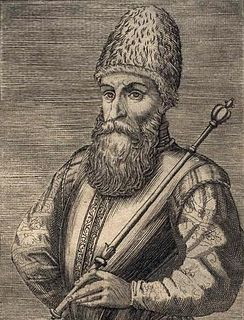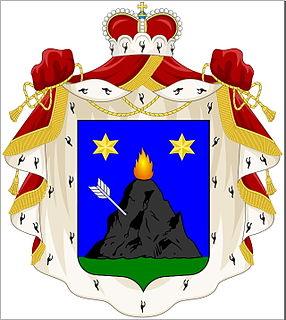Domentius I (Georgian :დომენტი I, Domenti I) was a Georgian churchman and the Catholicos Patriarch of Georgia who presided over the Georgian Orthodox Church in the latter half of the 16th century. Surviving documents testify to Domentius' efforts to aggrandize the church's land properties and restore those holdings that had earlier been lost to secular noble landlords.

Georgian is a Kartvelian language spoken by Georgians. It is the official language of Georgia. Georgian is written in its own writing system, the Georgian script. Georgian is the literary language for all regional subgroups of Georgians, including those who speak other Kartvelian languages: Svans, Mingrelians and the Laz.

The Georgian Apostolic Autocephalous Orthodox Church is an autocephalous Eastern Orthodox Church in full communion with the other churches of Eastern Orthodoxy. It is Georgia's dominant religious institution, and a majority of Georgian people are members. The Georgian Orthodox Church is one of the oldest churches in the world. It asserts apostolic foundation, and its historical roots must be traced to the early and late Christianization of Iberia and Colchis by Saint Andrew in the 1st century of new era and by Saint Nino in the 4th century AD, respectively.
According to the early-18th-century royal historian Prince Vakhushti, Domentius "was installed" as catholicos by King Simon I immediately after his accession to the throne of Kartli in eastern Georgia in 1556. Domentius' rule was limited to the eastern Georgian territories, with his see at Mtskheta; the west was under the jurisdiction of the breakaway Catholicate of Abkhazia. Even in the east, the Kingdom of Kakheti, run by a dynasty vying with their royal cousins in Kartli, tried to establish its own church. This attempt failed and Domentius was able to obtain pledges of loyalty from the Kakhetian bishops between 1556 to 1560. Further, in 1560, George, Crown Prince of Kakheti, restored to the see of Mtskheta a number of estates earlier lost by the church to that kingdom. [1]

Simon I the Great also known as Svimon (1537–1611), of the Bagrationi dynasty, was a Georgian king of Kartli from 1556 to 1569 and again from 1578 to 1599. His first tenure was marked by war against the Persian domination of Georgia. In 1569 he was captured by the Persians, and spent nine years in captivity. In 1578 he was released and reinstalled in Kartli. During this period, he fought as a Persian subject against the Ottoman domination of Georgia. In 1599 Simon I was captured by the Ottomans and died in captivity. During 1557 to 1569 he was known as Mahmud Khan and from 1578 to 1599 as Shahnavaz Khan

Mtskheta is a city in Mtskheta-Mtianeti province of Georgia. One of the oldest cities of Georgia, it is located approximately 20 kilometres north of Tbilisi, at the confluence of the Mtkvari and Aragvi rivers.
The Catholicate of Abkhazia was a subdivision of the Georgian Orthodox Church that existed as an independent entity in western Georgia from the 1470s to 1814. It was headed by the Catholicos, officially styled as the Catholicos Patriarch of Imereti, Odishi, Ponto-Abkhaz-Guria, Racha-Lechkhum-Svaneti, Ossetians, Dvals, and all of the North. The residence of the Catholicoi was at Bichvinta in Abkhazia, but was moved to the Gelati Monastery in Imereti in the late 16th century. In 1814, the office of the Catholicos of Abkhazia was abolished by the Russian Empire which would take control of the Georgian church until 1917.
There is no consensus as to the duration of Domentius' tenure. The catholicos named Domentius is known from two chronological groups of documents from the late 16th century. The church historian Michel Tamarati identifies two catholicoi with this name from that period, Domentius I (1557–1560) and Domentius II (1595–1602). [2] The Georgian Orthodox Church also follows this numbering, assigning the years 1556–1560 to Domentius I and c. 1595–1610 to Domentius II. [3] In contrast, some historians, such as Kalistrate Salia, consider these two Domentius to have been one person, with two tenures (1557–1562, 1599–1603) with a gap of nearly four decades. [2] [4]

Michel Tamarati, born Mikhail Tamarashvili, was a Georgian Roman Catholic priest and historian, known for his oft-cited French-language history of the Georgian Christianity L'Eglise géorgienne des origines jusqu' à nos jours published in Rome in 1910. He died while trying to rescue a drowning man in stormy sea near Santa Marinella, Italy.
Domentius II was a Georgian churchman and the Catholicos Patriarch of Georgia who presided over the Georgian Orthodox Church from c. 1595 to 1610. Like his predecessors, Domentius pushed for the efforts to aggrandize the church's land properties and restore the holdings that had earlier been lost to secular noble landlords. Some historians such as Kalistrate Salia consider this Domentius to have been the same person as the earlier Catholicos Domentius I, who might have occupied his office twice, with a significant gap of nearly four decades.










